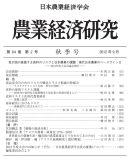All issues

Volume 84 (2012)
- Issue 4 Pages 203-
- Issue 3 Pages 157-
- Issue 2 Pages 57-
- Issue 1 Pages 1-
Volume 84, Issue 1
Displaying 1-2 of 2 articles from this issue
- |<
- <
- 1
- >
- >|
full-paper
-
Yousuke FUKUDA, Takumi KONDO2012 Volume 84 Issue 1 Pages 1-14
Published: June 25, 2012
Released on J-STAGE: March 31, 2015
JOURNAL FREE ACCESSInternational prices of cereals increased rapidly from 2006 through to the summer of 2008. Prices plummeted after summer 2008, but remain high relative to the level of 1997. The partial equilibrium model states that price increases spur an increase in crop production. This paper examines the influence of the increase in international cereal prices on Japanese agriculture, based on a single country computable general equilibrium model. The main results are as follows. First, an increase in international cereal prices increases agricultural output and farm labor input. It promotes production of wheat, soybean and feed crops with low self-sufficiency rates, and reduces production of other agricultural enterprises. Agricultural output prices and quantities are raised for all products. Farm labor in the livestock sector is decreased due to the great reduction in livestock production caused by the increase in feed prices, but farm labor is increased in the agricultural sectors as a whole, despite the decrease in labor input in livestock production. Second, the welfare level of consumers deteriorates. Consumption of food and nonalcoholic drinks declines and the level of GDP decreases a little. Third, productivity growth in agriculture mitigates the damage caused by price increases on lowered welfare levels for consumers and the fall in GDP.View full abstractDownload PDF (389K) -
Kunio NISHIKAWA2012 Volume 84 Issue 1 Pages 15-31
Published: June 25, 2012
Released on J-STAGE: March 31, 2015
JOURNAL FREE ACCESSThe theme of this article is to show the development logic of rice direct marketing by farmers on the present dimension and to obtain the suggestion that rice direct marketing has stagnated from a macroscopic view. I will notice the demand structure of rice and the structure of productive force, and will take up an example of Tayagawa area, Chikusei City, Ibaraki Prefecture. Conclusions of this article are as follows. Farmers need to cut down distribution cost and to lower the selling price by developing a lot of deals. Advancement of the structure of productive force makes it possible to sell directly, and is therefore required. It is suggested that paddy fields farmers who can do direct marketing in earnest are limited by this factor.View full abstractDownload PDF (833K)
- |<
- <
- 1
- >
- >|